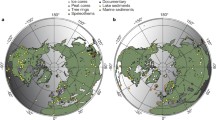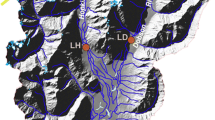Abstract
The reliability of quantitative paleoenvironmental reconstructions from lake sediment cores depends in part on the accuracy of the environmental data used in calibration. For paleoclimate reconstructions, gridded datasets provide convenient and consistent modern climate data for calibration. We show, however, that commonly used gridded climate data may have regional biases, which can affect calibration models and the paleoclimate reconstructions derived from them. Although there may be few alternatives to their use, researchers should be aware of potential problems, especially if unusual or counter-intuitive calibration models or reconstructions are obtained.



Similar content being viewed by others
References
Atkinson D, Gajewski K (2002) High-resolution estimation of surface air temperature in the Canadian Arctic Archipelago. J Clim 15:3601–3614
Barley EM, Walker IR, Kurek J, Cwynar LC, Mathewes RW, Gajewski K, Finney BP (2006) A northwest North American training set: distribution of freshwater midges in relation to air temperature and lake depth. J Paleolimnol 36:295–314
Birks HJB (1995) Quantitative paleoenvironmental reconstructions. In: Maddy D, Brew JS (eds) Statistical modeling of Quaternary science data. Quaternary Research Association, London, pp 161–254
Birks HJB, Heiri O, Seppä H, Bjune AE (2010) Strengths and weaknesses of quantitative climate reconstructions based on late-Quaternary biological proxies. Open Ecol J 3:68–110
Bouchard G, Gajewski K, Hamilton P (2004) Freshwater diatom biogeography in the Canadian Arctic Archipelago. J Biogeogr 31:1955–1973
Bryson R (1985) On climatic analogues in paleoclimatic reconstruction. Quat Res 23:275–286
Bunbury J, Gajewski K (2008) Does a one point sample adequately characterize the lake environment for paleoenvironmental calibration studies? J Paleolimnol 39:511–531
Bunbury J, Gajewski K (2009) Biogeography of freshwater ostracods in the Canadian Arctic. Arctic 63:324–332
Fortin M-C (2010) Postglacial Chironomidae population responses to climate-driven variations in lake aquatic productivity in the Canadian Arctic Archipelago. PhD thesis, University of Ottawa, Department of Biology
Fortin M-J, Dale M (2005) Spatial analysis: a guide for ecologists. Cambridge University Press, Cambridge, p 365
Fortin M-C, Gajewski K (2009) Assessing sediment production indices in Arctic lakes. Polar Biol 32:985–998
Fortin M-C, Gajewski K (2010a) Holocene climate change and its effect on lake ecosystem production on Northern Victoria Island, Canadian Arctic. J Paleolimnol 43:219–234
Fortin M-C, Gajewski K (2010b) Postglacial environmental history of western Victoria Island, Canadian Arctic. Quat Sci Rev 29:2099–2110
Gajewski K (1983) On the interpretation of climatic change from the fossil record: climatic change in central and eastern United States for the past 2000 years estimated from pollen data. PhD thesis, University of Wisconsin, Department of Meteorology
Gajewski K (2002) Modern pollen assemblages in lake sediments from the Canadian Arctic. Arct Antarct Alp Res 34:26–32
Gajewski K, Vance R, Sawada M, Fung I, Gignac LD, Halsey L, John J, Maisongrande P, Mandell P, Mudie P, Richard P, Sherrin A, Soroko J, Vitt D (2000) The climate of North America and adjacent ocean waters ca. 6 ka. Can J Earth Sci 37:661–681
Gajewski K, Viau A, Sawada M, Atkinson D, Wilson S (2001) Sphagnum peatland distribution in North America and Eurasia during the past 21,000 years. Global Biogeochem Cycles 15:297–310
Gajewski K, Lezine A-M, Vincens A, Delestan A, Sawada M, APD members (2002) Modern climate-vegetation-pollen relations in Africa and adjacent areas. Quat Sci Rev 21:1611–1631
Gajewski K, Bouchard G, Wilson S, Kurek J, Cwynar J (2005) Distribution of Chironomidae (Insecta: Diptera) head capsules in recent sediments of Canadian Arctic lakes. Hydrobiologia 549:131–143
Garneau M, Alt B (eds) (2000) Environmental response to climate change in the Canadian High Arctic. Geological Survey of Canada Bulletin 529, Ottawa
Hamilton P, Gajewski K, Atkinson D, Lean D (2001) Physical and chemical limnology of 204 lakes from the Canadian Arctic Archipelago. Hydrobiol 457:133–148
Hijmans RJ, Cameron SE, Parra JL, Jones PG, Jarvis A (2005) Very high resolution interpolated climate surfaces for global land areas. Int J Climatol 25:1965–1978
Larocque I, Pienitz R, Rolland N (2006) Factors influencing the distribution of chironomids in lakes distributed along a latitudinal gradient in northwestern Québec, Canada. Can J Fish Aquat Sci 63:1286–1297
New M, Lister D, Hulme D, Makin I (2002) A high-resolution data set of surface climate over global land areas. Clim Res 21:1–25
Rolland N, Porinchu DF, Larocque I (2009) The use of high resolution gridded climate data in the development of chironomid-based inference models from remote areas. J Paleolimnol 41:343–348
Sawada M, Viau A, Vettoretti F, Peltier WR, Gajewski K (2004) Comparison of North-American pollen-based temperature and global lake-status with CCCma AGCM2 output at 6 ka. Quat Sci Rev 23:225–244
Telford RJ, Birks HJB (2005) The secret assumption of transfer functions: problems with spatial autocorrelation in evaluating model performance. Quat Sci Rev 24:2173–2179
Telford RJ, Birks HJB (2009) Evaluation of transfer functions in spatially structured environments. Quat Sci Rev 28:1309–1316
ter Braak C, Šmilauer P (2002) CANOCO for Windows: software for community ordination (v4.5). Microcomputer Power, Ithaca New York. (www.microcomputerpower.com/)
Viau A, Gajewski K (2009) Reconstructing millennial-scale, regional paleoclimates of boreal Canada during the Holocene. J Clim 22:316–330
Viau A, Gajewski K, Sawada M, Fines P (2006) Millennial-scale temperature variations in North America during the Holocene. J Geophys Res 111:D09102. doi:10.1029/2005JD006031
Viau A, Gajewski K, Sawada M, Bunbury J (2008) Low- and High-frequency climate variability in Beringia during the past 25,000 years. Can J Earth Sci 45:1435–1453
Whitmore J, Gajewski K, Sawada M, Williams JW, Minckley T, Shuman B, Bartlein PJ, Webb T, Viau AE, Shafer S, Anderson P, Brubaker L (2005) Modern pollen data from North America and Greenland for multi-scale paleoenvironmental applications. Quat Sci Rev 24:1828–1848
Williams J, Shuman B (2008) Obtaining accurate and precise environmental reconstructions from the modern analog technique and North American surface pollen dataset. Quat Sci Rev 27:669–687
Acknowledgments
This research was funded by the Natural Sciences and Engineering Research Council of Canada (NSERC) and the Canada Foundation for Climate and Atmospheric Sciences (CFCAS), ACVAST project.
Author information
Authors and Affiliations
Corresponding author
Rights and permissions
About this article
Cite this article
Fortin, MC., Gajewski, K. Potential problems with the use of gridded climate data in regional quantitative paleoenvironmental studies from data-poor regions. J Paleolimnol 48, 641–650 (2012). https://doi.org/10.1007/s10933-012-9639-9
Received:
Accepted:
Published:
Issue Date:
DOI: https://doi.org/10.1007/s10933-012-9639-9




